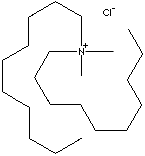PRODUCT IDENTIFICATION

230-525-2
H.S. CODE
TOXICITY
CLASSIFICATION
PHYSICAL AND CHEMICAL PROPERTIES
white powder
MELTING POINT
0.94
SOLUBILITY IN WATER
Freely soluble
7.0 (10% sol.)
REFRACTIVE INDEX
NFPA RATINGS
Health: 2, Flammability: 3, Reactivity: 0
AUTOIGNITION
24 C
GENERAL DESCRIPTION & APPLICATIONS
- Benzalkonium Chloride ( CAS RN: 8001-54-5)
- Benzethonium Chloride CAS 121-54-0
- Cetalkonium Chloride( CAS 122-18-9)
- Cetrimide ( CAS 8044-71-1)
- Cetrimonium Bromide ( CAS 57-09-0)
- Cetylpyridinium Chloride (CAS 123-03-5)
- Stearalkonium Chloride ( CAS 122-19-0)
They have properties of disrupting micro-organisms' cell processes and surfactants. These compounds are used as
- Active Ingredient for Conditioners
- Antistatic Agent
- Detergent Sanitisers
- Softner for textiles and paper products
- Phase Transfer Catalyst
- Antimicrobials
- Disinfection Agents And Sanitizers
- Slimicidal Agents
- Algaecide
- Emulsifying Agents
- Pigment Dispersers
BASE
APPEARANCE
white powder
99.0% min
WATER
0.5% max
HEAVY METAL
20ppm max
80%
APPEARANCE
Clear to light-straw colored liquid
80.0% min
ALCOHOL + WATER
Balance
COLOR, APHA
300 max
FREE AMINE
2.0% max
50%
APPEARANCE
Clear to light-straw colored liquid
50.0% min
ALCOHOL + WATER
Balance
COLOR, APHA
100 max
FREE AMINE
2.0% max
8 (Packing group III)
1903
Brand
Names:
Aliquat 203; Bardac 22; Bio-dac 50-22;
BTC 1010; BTCO 1010; DAQ1010-5;
- Mercuric Chlorides
- Formaldehyde
- 8-Hydroxyquinoline
- Copper Hydroxide
- Cresols
- Alcohols (Ethyl Alcohol; Isopropyl Alcohol)
- Iodines / Iodophors
- Chlorine releasing compounds
- Gluteraldehyde
- Phenolics
- Quaternary Ammonium Compounds